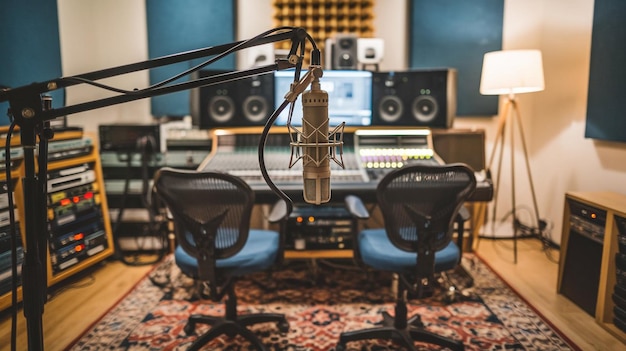Podcasts’ Influence on Mainstream Media: A 2025 Outlook

The year 2025 marks a crucial point where podcasts, once niche audio content, have profoundly reshaped mainstream media landscapes, compelling traditional outlets to adapt formats and content strategies to a more intimate and on-demand consumption model while fostering new journalistic frontiers and diverse voices.
In an increasingly fragmented media landscape, understanding The Influence of Podcasts on Mainstream Media: A 2025 Perspective is crucial. What began as an independent audio movement has blossomed into a formidable force, compelling traditional outlets to re-evaluate their strategies and embrace new forms of storytelling. This exploration delves into how podcasts have not just carved out their own space, but actively reshaped the future of news, entertainment, and public discourse, leading us to a 2025 where audio reigns.
The Evolution of Audio Content: From Niche to Necessity
The journey of podcasts from obscure hobby projects to mainstream media powerhouses has been nothing short of meteoric. Early adoption was slow, primarily driven by tech enthusiasts and independent creators experimenting with digital audio distribution. However, the inherent flexibility and intimate nature of podcasts began to resonate deeply with audiences seeking alternatives to traditional broadcast media.
By the mid-2010s, breakthrough true-crime series and narrative journalism podcasts demonstrated the commercial and cultural viability of the medium. This surge in popularity attracted significant investment, leading to professionalization and a dramatic increase in production quality. The accessible nature of podcast consumption, allowing listeners to engage while commuting, working out, or performing chores, further fueled its growth, embedding it into daily routines. This convenience transformed it from a niche interest into an everyday necessity for millions globally.
Audience Migration and Engagement Metrics
One of the most significant impacts of podcasts has been the gradual but consistent migration of audience attention away from traditional radio and, to some extent, television. Podcast listeners often exhibit higher engagement levels, characterized by longer listening durations and a greater willingness to explore diverse topics. This deep engagement stems from the conversational, often unscripted, and personalized feel of many podcasts, which fosters a strong sense of connection between hosts and listeners.
- "Always on" accessibility and on-demand nature
- Personalized content discovery through algorithms
- Deep dives into specific, often niche, subjects
- Intimate, conversational connection with hosts
The data clearly illustrates this shift: listenership demographics expanded beyond early adopters to encompass a broad spectrum of ages and interests. Advertisers took note, recognizing the highly engaged and often affluent audience base. This financial backing further solidified the podcasting industry’s position, allowing for more ambitious projects and continued innovation, establishing audio as a fundamental component of the contemporary media diet.
What started as a modest experiment has now cemented its place as an indispensable element of how individuals consume information and entertainment. The intimate nature of the medium, combined with its boundless thematic possibilities, ensures its enduring relevance.
Podcasting’s Influence on Traditional Broadcast Media
The advent of podcasting has compelled traditional broadcast media to critically re-evaluate their strategies and adapt to evolving listener preferences. Radio, in particular, has felt the direct competitive pressure, responding by incorporating podcast-like formats and investing in on-demand audio content of their own. This shift is visible in the proliferation of radio shows that also release as podcasts, often with extended, exclusive content available only in the podcast version.
Television news, too, has observed the success of long-form narrative podcasts and has begun experimenting with similar deep-dive approaches in documentary series and investigative journalism. The intimacy of audio, allowing for nuanced discussions and personal stories, has highlighted a gap in traditional broadcast’s often time-constrained formats. This has led to a cross-pollination of ideas, with traditional media learning from the agile, direct-to-consumer model of podcasts.
Reformatting Content and Distribution
Traditional media outlets are no longer just producing content for linear broadcast schedules. They are actively reformatting existing content and creating new material specifically for podcast distribution. This includes converting daily news briefings into digestible audio summaries, transforming interview segments into standalone podcast episodes, and developing entirely new series that leverage sound design and narrative techniques perfected by independent podcasters. The goal is to meet audiences where they are, on platforms of their choosing, mirroring the on-demand mindset cultivated by streaming services.
- Creation of original podcast series by major news organizations
- Repurposing of broadcast content for audio-only consumption
- Investment in dedicated podcast studios and production teams
- Experimentation with shorter, digestible "audio snacks"
This strategic move is vital for maintaining relevance in a digitally-native environment. By embracing podcasting, traditional broadcasters can retain their established audience while attracting new, younger demographics accustomed to on-demand consumption. The flexibility of podcasting allows for a less formal, more conversational tone, which resonates deeply with contemporary audiences tired of traditional, often rigid, broadcast styles. This embrace ensures that their authoritative voice remains strong across all platforms, adapting without losing foundational credibility.
The imperative to adapt is clear: traditional media must innovate or risk being left behind in the rapidly evolving audio landscape. Podcasts have effectively demonstrated that long-form, intimate audio has a significant and dedicated audience.

The Rise of Audio-First Journalism and Storytelling
Podcasting has not merely influenced existing media; it has actively pioneered new forms of journalism and storytelling. The medium’s unique characteristics— intimacy, flexibility in length, and low barrier to entry—have fostered an environment ripe for innovation. This has led to the emergence of rich, immersive audio narratives that can explore complex topics with a depth rarely afforded by visual mediums or time-constrained broadcasts of yesteryear.
Audio-first journalism often prioritizes the spoken word and soundscape, creating a direct, unfiltered connection with the listener. This mode of storytelling allows for a nuanced exploration of human experiences, often capturing raw emotion and intricate details that might be lost in visual translation. Investigative journalism, for instance, has found a powerful new home in podcasting, enabling serial narratives that unfold over weeks or months, reminiscent of long-form print journalism but delivered directly to the ear.
Narrative Depth and Experiential Listening
One of the most compelling aspects of audio-first storytelling is its ability to create experiential listening. Listeners become active participants, using their imagination to fill in visual gaps, which can lead to a more profound and personal connection with the content. Sound design plays a crucial role in this, using ambient sounds, music, and voice modulation to set scenes, convey mood, and enhance the narrative arc.
- Immersive soundscapes for deeper engagement
- Serial narratives that sustain listener attention
- Focus on character development through voice
- Lower production costs compared to video storytelling
This narrative depth has allowed for extensive explorations of niche topics, historical events, and personal memoirs that might struggle to find a platform in mainstream visual media. The absence of visual distractions can intensify focus, allowing listeners to absorb complex information or follow intricate storylines without interruption. For journalists, it’s an opportunity to build trust through the directness of their voice, forging a unique bond with their audience that is distinct from print or video. This directness cultivates a level of trust and engagement that is proving highly valuable in a fragmented media landscape.
The intimacy of audio allows for unfiltered expressions and stories that resonate emotionally. This shift towards deeply personal and detailed narratives marks a significant evolution in how information and entertainment are consumed, emphasizing depth over superficiality.
Podcasts as Platforms for Diverse Voices and Niche Content
Perhaps one of the most transformative impacts of podcasting has been its democratization of media. Unlike traditional gatekept media, podcasting offers a relatively low barrier to entry, empowering individuals and communities to share their unique perspectives and create content that speaks directly to niche audiences. This has led to an explosion of diverse voices that were historically underrepresented or entirely absent from mainstream channels.
From podcasts focusing on specific cultural identities to those dedicated to hyper-specialized hobbies, the medium thrives on its ability to cater to almost any interest. This accessibility fosters a rich tapestry of content, reflecting the true diversity of human experience. It also provides a vital platform for independent journalism, advocacy, and educational initiatives, bypassing traditional editorial filters that can sometimes limit experimental or controversial content. This decentralized nature ensures that a wider array of viewpoints can be heard and discussed.
Community Building and Direct Engagement
Podcasts, by their very nature, excel at building strong, engaged communities. Listeners often feel a personal connection to their favorite hosts, fostering a sense of belonging that transcends merely consuming content. This direct engagement is often facilitated through social media, listener mail, and live events, creating a two-way dialogue rarely achieved by traditional mass media.
- Empowerment of independent creators and marginalized voices
- Creation of hyper-focused interest communities
- Direct interaction channels between hosts and audience
- Increased representation of diverse cultural narratives
For advertisers and brands, this represents a highly attractive proposition: access to dedicated, passionately engaged audiences. The success of podcasts in cultivating these niche communities has forced mainstream media to reconsider their own engagement strategies. They are now actively seeking ways to foster similar connections with their audiences, often through companion podcasts or interactive online features. The vibrant ecosystem of niche podcasts proves that depth and specificity often trump broad appeal, especially in a digital age where choice is abundant. This empowers voices that otherwise may not have been heard, enriching public discourse.
The ability to connect with highly specific demographics has made podcasts indispensable for cultural movements and specialized industries. This community-driven aspect ensures that the content remains relevant and continues to evolve with its audience.
Monetization Paradigms and Economic Impact
As podcasts have matured, so too have their monetization models, significantly impacting the economic landscape of mainstream media. Initially dominated by direct sponsorships, the industry has diversified, embracing dynamic ad insertion, subscription models, premium content, and even live events. This diversification has created new revenue streams that traditional media companies are keenly observing and, in many cases, adopting for their own digital content.
The precision targeting offered by podcast advertising, coupled with the high engagement of listeners, makes it an attractive proposition for brands. Unlike traditional broadcast commercials, podcast ads are often read by the hosts themselves, making them feel more authentic and less intrusive. This authenticity translates to higher ad recall and conversion rates, further solidifying podcasting’s economic viability and attracting significant ad spend away from older media formats. The industry’s rapid growth has also spawned new ancillary businesses, including analytics platforms, hosting services, and production houses, creating a robust ecosystem.
Shifting Ad Spend and Subscription Models
The substantial shift in advertising budgets towards podcasting is one of its most potent economic influences. Brands are increasingly reallocating funds previously reserved for radio or even television to capitalize on podcasting’s engaged audience and unique advertising opportunities. This has prompted traditional media to develop more sophisticated digital advertising strategies, incorporating similar direct-response and native advertising techniques.
- Rise of dynamically inserted and programmatic audio ads
- Growth of premium podcast subscriptions and patreon models
- Increased brand partnerships and sponsored content
- Investment in exclusive content to drive subscriber growth
Furthermore, the success of subscription-based podcast platforms and individual creator models (like Patreon) has demonstrated the audience’s willingness to pay for high-quality audio content. This trend has encouraged mainstream media to explore and expand their own paywall and subscription offerings for digital news and entertainment, recognizing the value audiences place on exclusive, ad-free, or enhanced experiences. The economic engine of podcasting, built on innovation and direct audience support, continues to reshape how content is funded and consumed, proving that quality content can command direct financial support. This economic model presents a compelling case for a future where content valuation is increasingly driven by direct consumer contributions.
The financial success of many podcasts provides a blueprint for sustainable media ventures outside traditional structures. This economic shift validates the value of deep, highly engaged audiences over sheer volume, prompting reevaluation across the media industry.
Regulatory Scrutiny and Future Challenges in 2025
As podcasts solidify their position in the mainstream media landscape by 2025, they inevitably face increased regulatory scrutiny and a unique set of challenges. The very low barrier to entry that has fueled their growth also means less editorial oversight compared to traditional media, leading to concerns about misinformation, libel, and ethical reporting standards. Governments and media watchdogs globally are grappling with how to apply existing regulations, or create new ones, to a medium that defies easy categorization.
Questions surrounding content moderation, especially for user-generated or live podcast content, intellectual property rights, and advertising transparency, are becoming critical. While self-regulation and platform guidelines have been the primary mechanisms to date, the growing influence and reach of podcasts suggest that more formal frameworks may be on the horizon. This balance between fostering free expression and ensuring accountability will be a defining challenge for the industry in the coming years.
Data Privacy & Content Moderation Concerns
The personalized nature of podcast advertising relies heavily on user data, raising significant privacy concerns. As data protection regulations (like GDPR and emerging US state laws) become stricter, podcast platforms and advertisers must navigate complex compliance issues. The industry faces the challenge of maintaining effective ad targeting while respecting user privacy, potentially leading to new data handling protocols and transparency requirements.
- Increased debate over content liability for platforms and hosts
- Development of industry-wide ethical guidelines and best practices
- Potential for new legislation on podcast advertising disclosure
- Challenges in balancing free speech with harmful content prevention
Content moderation also presents a formidable hurdle. With millions of podcasts covering every conceivable topic, policing hate speech, incitement to violence, and overt misinformation without stifling legitimate discourse is a monumental task. The decentralized nature of podcasting makes a uniform approach difficult, leading to a patchwork of platform-specific policies and public pressure campaigns. The industry must collectively address these challenges to maintain its credibility and avoid heavy-handed external regulation. Navigating these regulatory waters requires careful consideration to protect the dynamism that defines the medium. Striking a balance between innovation and responsibility is paramount for sustainable growth.
Addressing these challenges proactively will be essential for podcasts to retain their autonomy and continue evolving. A collaborative effort between creators, platforms, and policymakers is critical to shaping a fair and effective regulatory future.
The Future of Audio: Integration and Interactivity in 2025
Looking ahead to 2025 and beyond, the influence of podcasts on mainstream media is set to deepen, driven by greater integration and enhanced interactivity. Audio is no longer a standalone medium but an integral component of a broader content ecosystem, seamlessly blending with video, text, and immersive technologies. This convergence means that listeners will experience content across multiple formats, switching effortlessly between watching a video, reading an article, and then listening to a companion podcast on the same topic.
Smart speakers and voice AI are also playing a crucial role, making audio content more accessible and intuitive than ever before. Instant access to news briefs, long-form discussions, and narrative stories via voice commands is becoming the norm, positioning audio content as a central element of the connected home. The future will see more personalization, dynamic content generation, and new forms of listener interaction that blur the lines between passive consumption and active participation, driven by AI and evolving audio technologies. This push towards seamless integration offers new avenues for content creators and consumers alike.
Personalization, AI, and Immersive Audio Experiences
In 2025, artificial intelligence will increasingly power hyper-personalized podcast recommendations and even dynamic content generation tailored to individual listener preferences. AI can analyze listening habits, emotional responses, and even environmental factors to deliver the most relevant and engaging audio experience. This could extend to adaptive content that adjusts based on a listener’s location or current activity, offering a truly bespoke audio journey.
- Hyper-personalized content recommendations via AI
- Emergence of interactive podcast formats
- Integration with augmented reality (AR) audio
- Dynamic content that adapts to listener context
Moreover, immersive audio technologies, such as spatial audio and augmented reality (AR) soundscapes, are moving beyond niche applications to become more commonplace. Imagine a true-crime podcast where the sound environment shifts to place you directly at the scene of the investigation, or a historical narrative that uses AR audio to recreate the sounds of a specific era as you walk through a museum. These advancements promise to transform passive listening into deeply engaging, multi-sensory experiences, setting a new standard for audio production and storytelling in mainstream media. The potential for these technologies to revolutionize how we consume and interact with audio is immense, promising a future where sound is not just heard, but profoundly felt. This marks a new frontier for audio content, promising an enriched and deeply personal listening journey unlike anything experienced before.
The convergence of advanced technology with compelling narratives indicates a thrilling future for audio content. Podcasts are at the forefront of this evolution, continually pushing the boundaries of what is possible in auditory media.
| Key Area | Transformative Impact (2025) |
|---|---|
| 🎧 Audience Shift | Listeners increasingly favor on-demand, intimate audio, compelling traditional media to adapt their formats and distribution for deeper engagement. |
| 🎙️ Content Innovation | Podcasts drive audio-first journalism, fostering narrative depth and diverse voices often absent from mainstream channels, creating rich, immersive experiences. |
| 💸 Economic Model | Diversified monetization (sponsorships, subscriptions) shifts ad spend and validates direct audience support, influencing traditional media’s digital strategies. |
| 🔮 Future Trends | Integration with AI and smart speakers, personalized content, and immersive audio experiences are set to redefine the future of media consumption. |
Frequently Asked Questions About Podcasts and Mainstream Media
By 2025, podcasts have pushed traditional radio to adopt on-demand models and integrate podcast-like formats. Many radio shows now release dedicated podcast versions, often including exclusive content. This has forced radio to innovate its programming, focusing on intimate, conversational styles and niche topics to compete effectively with the vast array of available audio content and retain listener engagement in a digital-first world.
Yes, major news organizations are heavily investing in podcasts due to their ability to foster deep engagement and attract younger demographics. Podcasts allow for long-form investigative journalism and nuanced storytelling that isn’t always possible in traditional broadcast. They also offer new monetization avenues through direct sponsorships and subscriptions, diversifying revenue streams beyond advertising models traditionally used in print and television news.
Podcasts have revolutionized media by democratizing content creation, providing a powerful platform for diverse voices and niche topics previously underrepresented in mainstream media. Their low barrier to entry enables individuals and communities to share unique perspectives, fostering hyper-focused communities around specific interests. This has significantly enriched the media landscape, promoting inclusivity and catering to highly specific audience demands with authentic, direct content.
By 2025, podcast monetization has diversified beyond simple sponsorships to include dynamic ad insertion, subscription models for premium content, and live events. This evolution allows for tailored advertising and direct listener support, which are highly attractive to brands due to elevated listener engagement. These models have influenced mainstream media to explore similar subscription and direct-to-consumer revenue streams for their own digital offerings.
In 2025, podcasts face increasing regulatory scrutiny regarding misinformation, ethical reporting standards, and libel due to their decentralized nature. Challenges include content moderation without stifling free speech, ensuring data privacy for personalized advertising, and clarifying intellectual property rights. The industry grapples with finding a balance between fostering innovation and implementing accountability frameworks, potentially leading to new guidelines and self-regulatory initiatives across the sector.
Conclusion: The Enduring Echo of Audio Innovation
By 2025, the influence of podcasts on mainstream media is undeniably profound and permanent. What began as a nascent digital trend has evolved into a fundamental pillar of how content is created, consumed, and monetized. Podcasts have not merely coexisted with traditional media; they have actively reshaped it, fostering an environment where intimacy, authenticity, and on-demand access are paramount. This transformation has compelled established outlets to adapt, innovate their storytelling, and embrace new forms of engagement, ultimately enriching the entire media ecosystem. As technology continues to advance, promising even deeper integration and interactivity, podcasts will undoubtedly remain at the forefront of audio innovation, continuing to define the sound of our interconnected world.





